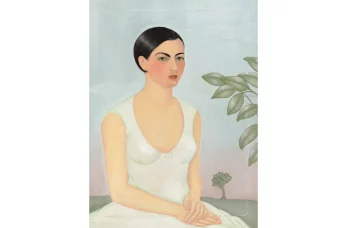On 115 South Pulaski Avenue, on the upstairs wall of the Legler Branch public Library in Chicago’s West Garfield neighborhood, hangs a rare treasure: a mural by the famed artist Kerry James Marshall. The city of Chicago originally bought “Knowledge and Wonder,” painted in 1995, for $10,000. It is now estimated to be worth over $10 million.
When the city announced that it would be auctioning the painting to fund much-needed renovations for the struggling library, the news drew sharp criticism. “If you’ve got a good idea to help us hold on to that Kerry James Marshall piece I’d love it — love it,” Mayor Rahm Emanuel first told the Chicago Tribune. “But you’re going to have to give me a solution to 45 years of social, educational, cultural and economic inequity to the West Side. You don’t get to pick one side of that argument.” After the controversy exploded, he later reversed his decision.
In 2016, a retrospective of Kerry James Marshall’s work, Mastry, organized by the Museum of Contemporary Art Chicago, in collaboration with the Metropolitan Museum of Art and the Museum of Contemporary Art, cemented the artist’s superstar status. In the twenty plus years since “Knowledge and Wonder” was first created, the sale of Marshall’s works has skyrocketed. This past May, his “Past Times,” which was displayed as part of the retrospective, was sold for a record-breaking $21.1 million.
Marshall was born in 1955 in Birmingham, Alabama as the Civil Rights movement was beginning to gain steam. At eight, the artist moved to South Central, Los Angeles, which would become embroiled in racial tensions of its own. The year of the Watts Riots, Marshall would visit the Los Angeles County Museum of Art: “I went from floor to floor looking at everything, in the same way that in the library I went down the stacks and looked at every art book, without discrimination.” While absorbing the great artworks of the Western canon, he also noticed a glaring lack: the absence of black bodies.
Marshall celebrates the black figure at a time when figurative painting—and even the medium of painting itself—is said to be over. As artist Calvin Reid wrote, “Marshall paints large, allegorical, allusive paintings invigorated by a complex conceptual weave of personal and social history, African American popular culture, African diasporan folk material, and a refreshing sense of awe and challenge in the face of Western painting’s daunting historical legacy.” The paintings represent a complex synthesis of culture, owing as much to medieval and Renaissance painters such as Holbein and Rembrandt as to blues music and the occult rituals of Santería. They celebrate black bodies while also reckoning with the precarity of those bodies in the United States: a reckoning with a violent and ongoing history. As Marshall says about his work, “blackness is non-negotiable in these pictures; it’s also unequivocal.”
Marshall, who arrived in Chicago in the eighties and still works in the same Bronzeville studio as he has for years, has been called by Emanuel an ambassador of the city. With the painting thankfully remaining in place, it can now continue to serve its important cultural role for the people of Chicago, particularly the underserved black communities who form the inspiration for the work.
To remove the public art from its context, says Marshall, would be to diminish its meaning. The library and its constituents are as much part of the painting as anything else.
As he told the Chicago Tribune: “When you make a work like that, you hope it has a certain sort of instrumentality, that it can be used for something. Thematically, it’s an invitation to enter a world of knowledge and imagination. It’s structured in such a way that for anybody who’s looking at it there’s no barrier to entering the world that those books open up. The spectator is as much a part of that galaxy of incredible and informative things as the people in the picture are.” Preserving the painting for the library gives generations of children what Marshall did not have access to as a boy wandering the museum halls: the opportunity to see oneself reflected back in art.





